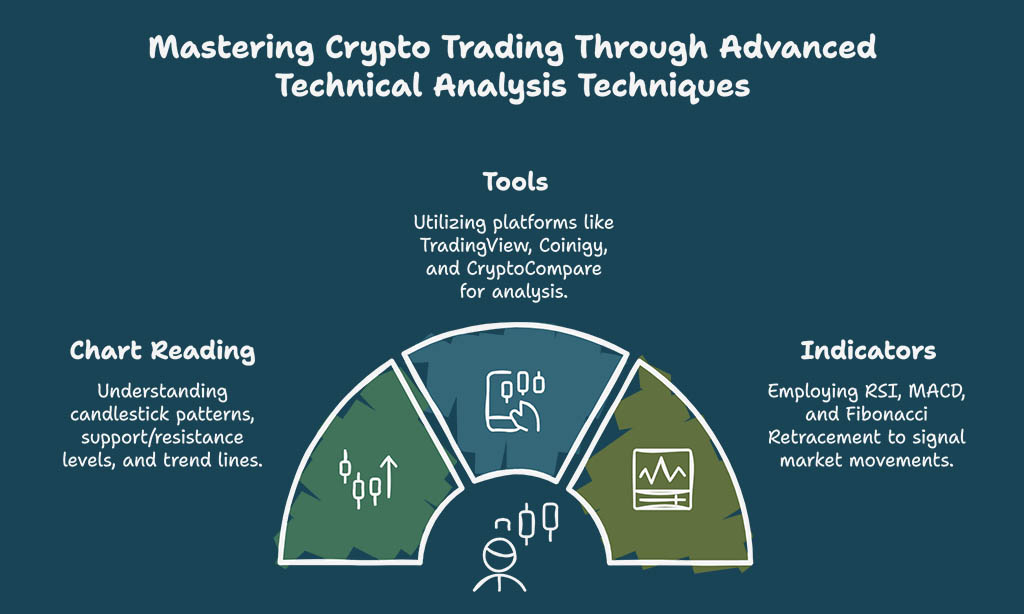Cryptocurrency trading has undergone a massive transformation over the last decade. What once was a niche activity dominated by tech-savvy enthusiasts has evolved into a globally recognized financial market with billions in daily trading volume.
The rise of institutional investors, the introduction of sophisticated trading platforms, and the emergence of complex financial instruments have elevated the stakes. Today, traders are operating in an environment driven by data, automation, and real-time decision-making.
As the market matures, the margin for error narrows. Beginners may still depend on intuition or basic chart signals, but seasoned investors know that consistent profits stem from disciplined, strategic approaches rooted in data and technology. It’s not enough to “buy the dip” or follow hype-driven narratives — mastering the crypto market demands a nuanced, research-heavy framework that adapts to market volatility, economic shifts, and global sentiment.
In this comprehensive guide, we’ll dive deep into 10 advanced crypto trading techniques for seasoned investors.
Advanced Crypto Trading Techniques for Seasoned Investors
These aren’t your typical tips — each technique is designed to give you an edge in a complex, fast-moving market. Whether you’re trading Bitcoin, Ethereum, or altcoins, the right tools and mindset can turn volatility into opportunity.
Let’s explore the cutting-edge strategies shaping successful crypto portfolios today.
1. Mastering Technical Analysis
Technical analysis is foundational for every serious crypto trader. It goes beyond simple patterns and involves studying price action, momentum, volume, and historical data to anticipate future price movements. Seasoned investors understand the importance of aligning multiple indicators across various timeframes to gain a more accurate market outlook. This approach helps identify the best possible entries and exits, significantly enhancing long-term profitability.
Unlike basic analysis, advanced technical trading involves the use of multiple timeframes, advanced indicators, and price action theory to identify high-probability setups.
How to Read Crypto Charts Like a Pro
Understanding candlestick patterns, support/resistance levels, and trend lines is essential. Daily, 4-hour, and 1-hour charts provide different insights. Traders should learn to interpret:
- Bullish/Bearish engulfing patterns
- Doji candles
- Head and shoulders formations
- Triangle breakouts
Best Tools for Technical Analysis
- TradingView – Offers advanced charting features and custom indicators
- Coinigy – Integrates multiple exchange accounts in one interface
- CryptoCompare – Provides comprehensive market data and visualization tools
Popular Technical Indicators:
| Indicator | Purpose | Signal Type |
| RSI (Relative Strength Index) | Identifies overbought or oversold conditions | Momentum |
| MACD (Moving Average Convergence Divergence) | Tracks momentum and trend direction | Trend Reversal |
| Fibonacci Retracement | Predicts support/resistance levels | Price Levels |
Pro Tip: Combine two or more indicators to confirm signals and reduce false positives. For example, an RSI below 30 and a bullish MACD crossover often signal a potential bottom.
2. Leveraging On-Chain Data
On-chain data is one of the most powerful tools available to crypto investors. It provides transparency into blockchain activity, allowing traders to track everything from wallet movements to miner behavior.
Unlike traditional financial markets, blockchain offers public data, which means savvy investors can access a real-time pulse of market activity. This visibility helps predict turning points, such as accumulation, distribution, or large-scale dumps.
For seasoned investors, on-chain data provides a powerful edge not visible in traditional technical indicators.
What On-Chain Metrics Reveal
- Active Addresses: Measures real usage and adoption
- Exchange Inflows/Outflows: Helps track whale movements and possible sell-offs
- Network Value to Transactions (NVT): Assesses market over/undervaluation
- Hash Rate: Signals network security and miner confidence
Case Example: In May 2021, a sharp increase in exchange inflows signaled a major sell-off before Bitcoin dropped over 30%. Traders using Glassnode saw this trend hours before the crash.
3. Using Algorithmic Trading Bots
Algorithmic bots have become a mainstay in modern crypto trading. They enable users to automate trading strategies, respond instantly to market conditions, and manage multiple positions across exchanges.
For advanced investors, bots also provide the ability to eliminate emotion, maintain discipline, and scale proven strategies with minimal manual intervention. Their versatility and around-the-clock functionality make them a vital tool for maximizing profitability in fast-moving markets.
Advanced bots can handle complex strategies, perform arbitrage, or even analyze technical indicators in real-time. They’re ideal for reducing screen time while maximizing opportunity.
Benefits and Limitations
| Benefit | Explanation |
| 24/7 Trading | Bots work round-the-clock, capturing moves in all time zones |
| Discipline | Executes strategies without emotional bias |
| Customization | Build or import specific strategies with condition triggers |
Limitations:
- Requires regular monitoring and maintenance
- Vulnerable to rapid market shifts or flash crashes
- Needs proper backtesting and error handling
Real Example: A trader using Cryptohopper’s dollar-cost averaging (DCA) bot during the 2022 bear market managed to build a solid ETH position with 20% lower average entry compared to manual buyers.
4. Spotting and Trading Market Cycles
Understanding market cycles is essential for long-term success in crypto trading. These cycles reflect the natural flow of markets influenced by human psychology, macroeconomic conditions, and innovation cycles in technology.
Recognizing each phase — from accumulation to markup to distribution to markdown — gives seasoned traders a framework to anticipate market behavior and adjust their positions proactively. This technique can prevent catastrophic losses and maximize gains when executed properly.
Understanding market cycles allows seasoned investors to optimize their entry and exit points, reducing the risks of buying at tops and selling at bottoms.
Phases of a Crypto Market Cycle
| Phase | Description | Common Emotions |
| Accumulation | Post-crash period, low volume | Disbelief, hope |
| Mark-Up | Rapid rise in price | Optimism, belief |
| Distribution | Prices top out, volume fades | Greed, euphoria |
| Mark-Down | Sharp decline | Fear, panic |
Chart Reference: The Wall Street Cheat Sheet is a well-known depiction of market psychology. Traders can map BTC or ETH prices to this chart to assess sentiment.
Practical Tip:
Use volume and RSI divergence to confirm distribution phases. For instance, falling volume and high RSI at a peak may suggest a looming downturn.
5. Advanced Risk Management Strategies
Effective risk management is the bedrock of sustainable crypto trading. It involves more than setting stop-losses — it’s about having a system that preserves capital, limits downside, and lets profits run when opportunities arise.
Advanced risk management incorporates statistical models, dynamic position sizing, and volatility-adjusted strategies that help experienced traders remain resilient through extreme market swings. Without it, even the best strategies are destined to fail.
It involves defining how much capital to risk per trade, setting boundaries for losses, and preparing for worst-case scenarios.
Key Principles:
| Strategy | Implementation |
| 1% Rule | Risk no more than 1% of capital per trade |
| Stop-Loss Orders | Limit losses automatically |
| Take-Profit Orders | Secure profits at predefined levels |
| Portfolio Diversification | Spread across assets and sectors |
Example: A $50,000 portfolio applying the 1% rule would only risk $500 per trade. Even after five losing trades, the drawdown would be limited to 5%, preserving capital.
Pro Insight: Use trailing stop-losses to protect gains as the market moves in your favor.
6. Arbitrage Opportunities in Real-Time
Arbitrage is a time-tested strategy that takes advantage of price discrepancies for the same asset across different exchanges. It’s especially effective in crypto, where fragmentation and global trading lead to frequent price inefficiencies.
Seasoned traders use bots and monitoring tools to execute quick buy-sell orders, securing near-instant profits. This technique requires fast execution, fee analysis, and operational precision, but when done right, it can generate consistent low-risk returns.
Due to the decentralized nature of crypto, inefficiencies often exist — especially between regions or low-volume exchanges.
How Arbitrage Works:
| Step | Description |
| 1 | Identify price difference across exchanges |
| 2 | Buy on lower-priced exchange |
| 3 | Transfer and sell on higher-priced exchange |
Considerations:
- Network congestion may delay transfers
- Withdrawals may be restricted or delayed
- Fees can eat into profit margins
Example: In December 2023, BTC was trading at a $400 premium on a South Korean exchange due to local demand — a phenomenon known as the “Kimchi Premium.” Traders exploiting this earned quick profits before the spread normalized.
7. Short Selling and Margin Trading
These high-leverage strategies allow traders to profit not only from bullish rallies but also from bearish downturns. Short selling involves borrowing an asset to sell it at a high price, then repurchasing it at a lower price to pocket the difference.
Margin trading enhances buying power, letting traders take larger positions with borrowed funds. Both are powerful tools but demand robust knowledge, emotional control, and real-time strategy adjustments to avoid devastating losses.
When used responsibly, they can significantly enhance returns — but they come with increased risk.
Understanding Leverage
Leverage allows traders to borrow capital to increase their trade size.
| Leverage | Effect | Risk Level |
| 2x | Doubles exposure | Moderate |
| 5x | 5 times exposure | High |
| 10x+ | High amplification | Very High |
When to Use Short Selling
- During confirmed downtrends
- After bearish chart patterns (e.g., descending triangles)
- Alongside risk controls like stop-loss orders
Warning: Over-leveraging has led to mass liquidations in major crypto crashes. In April 2021, over $10B in positions were liquidated in a single day due to excessive leverage.
8. Portfolio Diversification Across Blockchain Ecosystems
The crypto ecosystem is rapidly expanding beyond Bitcoin and Ethereum. New blockchain platforms bring innovations in speed, scalability, governance, and interoperability. Seasoned investors understand the importance of diversifying portfolios to include exposure to various blockchain ecosystems, reducing risk and capturing early gains in emerging sectors.
A well-diversified portfolio helps balance volatility while unlocking opportunities in DeFi, NFTs, and Layer 2 solutions.
In crypto, ecosystems like Ethereum, Solana, and Cosmos offer unique benefits.
Why Diversification Matters
| Benefit | Explanation |
| Reduce Volatility | Losses in one asset may be offset by gains in another |
| Capture Innovation | New ecosystems often outperform in bull runs |
| Balance Risk | Mix of large-cap and small-cap assets |
Practical Tip: Allocate 60% to stable large-caps (e.g., BTC, ETH), 30% to mid-caps (e.g., SOL, DOT), and 10% to emerging tokens.
9. Mastering Sentiment Analysis with AI Tools
Crypto markets are heavily influenced by crowd psychology, often driven by narratives and news cycles. Sentiment analysis uses AI to scan and interpret public opinion across social platforms, forums, and news outlets. By combining these insights with technical and fundamental data, seasoned traders can detect early signs of trend shifts or potential pumps and dumps. Modern sentiment tools apply NLP algorithms to analyze millions of data points in real time.
With AI and NLP tools, traders can scan social media, news, and forums to detect shifts in investor behavior.
Real-Time Sentiment Sources
| Source | Insight Type |
| Trending sentiment, meme coin buzz | |
| Retail investor views | |
| YouTube | Influencer-driven signals |
| News Feeds | Macro-level developments |
Example: In January 2024, sudden positive sentiment spikes around an Ethereum upgrade led to a 12% price jump within 24 hours — data spotted first on LunarCrush.
10. Developing a Personalized Trading Strategy
A personalized trading strategy is a blueprint for consistent success. It considers the trader’s risk tolerance, time availability, asset preferences, and psychological strengths. Unlike copy-trading or relying on public signals, a custom strategy empowers traders to think independently and make informed decisions.
Over time, it should be refined based on market feedback, performance metrics, and evolving goals. This flexibility is what separates professionals from amateurs.
Such a strategy evolves with market conditions and personal growth.
Components of a Good Strategy
| Element | Description |
| Risk Profile | Defines how much you’re willing to lose |
| Time Horizon | Day trading vs swing trading vs HODLing |
| Indicators | Tools used to make decisions |
| Entry/Exit Criteria | Rules for getting in and out |
Checklist:
- Have you defined your trade triggers?
- Are you tracking your trades and reviewing performance?
- Do you know when to pause trading during volatile markets?
Tip: Use journaling tools like Edgewonk or Tradelog to analyze trading behavior and identify patterns over time.
Final Thoughts
In the volatile world of crypto, experience alone isn’t enough. The key to success lies in applying advanced tools, adapting to market shifts, and mastering proven techniques. These 10 advanced crypto trading techniques for seasoned investors are designed to help you refine your edge, preserve capital, and grow your portfolio strategically.
Remember, the crypto market rewards those who stay informed, agile, and disciplined. By combining these techniques with constant learning and introspection, you can navigate any market condition with confidence.















































